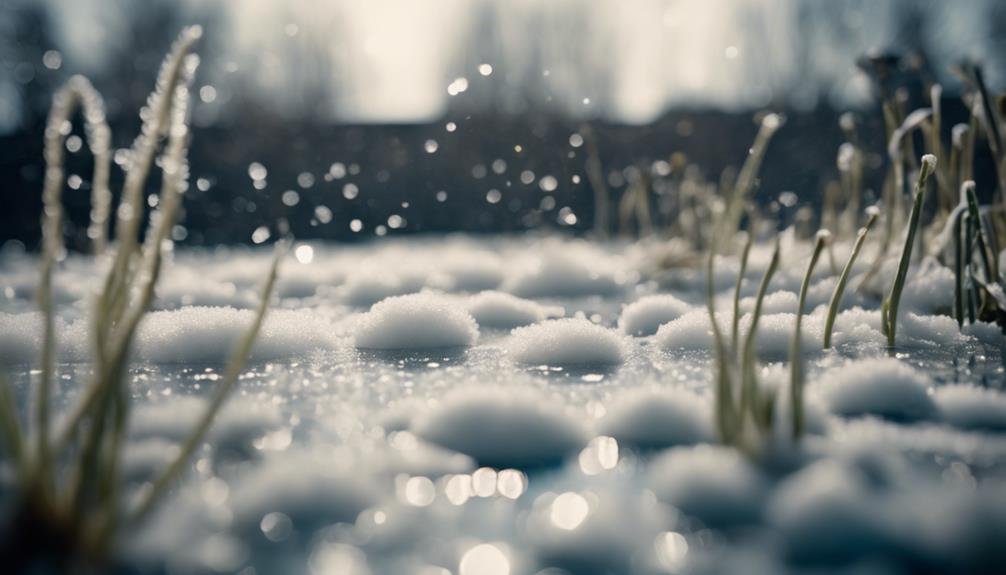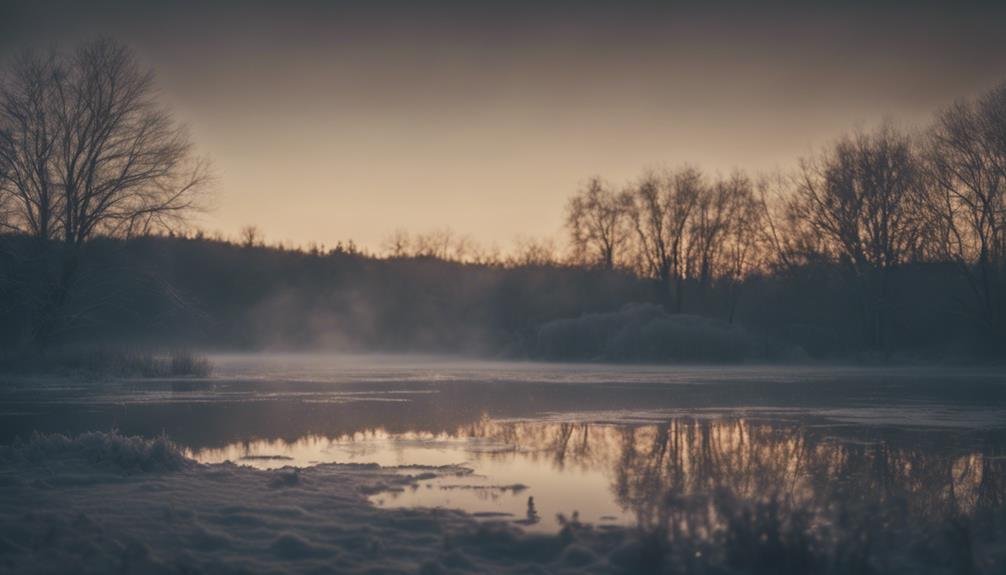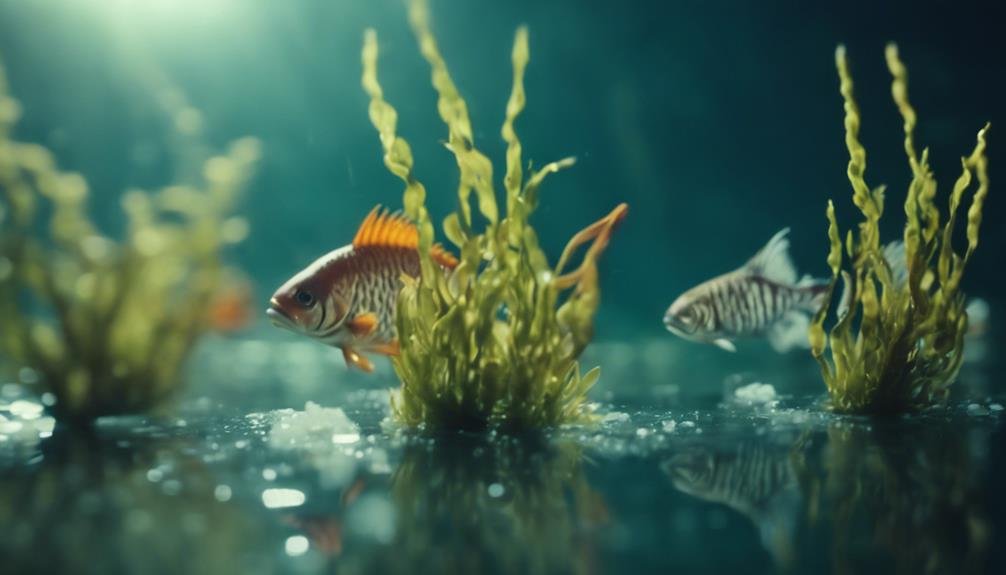De-icers play a crucial role in keeping ponds ice-free during the winter months to ensure that aquatic life can thrive. There are various types of de-icers available, such as floating units that sit on the surface, submersible ones that transfer heat underwater, and aeration systems that promote gas exchange.
It is essential to properly size and install de-icers, aiming for 1,500-2,000 BTUs per square foot of the pond's surface area. Safety measures include grounding the units, using outdoor-rated cords, and conducting regular maintenance checks.
Choosing eco-friendly and pet-safe de-icers not only protects wildlife but also helps to maintain optimal gas levels in the pond. By selecting products that are both effective and environmentally conscious, pond owners can ensure a healthy winter environment for their aquatic ecosystem.
For more detailed guidance on creating a safe and sustainable winter pond habitat, follow the step-by-step instructions provided.
Necessity of De-Icers
During winter, ponds can become covered in ice, which hinders the exchange of gases essential for aquatic life. To prevent harmful gas build-up and ensure fish and other creatures have enough oxygen, using de-icers is crucial. These devices create a small opening in the ice, allowing oxygen to enter the water and maintaining a healthy environment for aquatic life.
There are different types of de-icers available, some that float on the surface and others that are mounted at the edge of the pond. Both varieties work by circulating warmer water to prevent the formation of ice. Proper placement of the de-icer is important for maximum effectiveness, ideally near the deepest part of the pond where fish congregate during cold weather.
Types of De-Icers
There are various types of de-icers to choose from for your pond. Floating de-icers are easy to install and sit on the pond's surface, melting ice with heating elements. Some models even come with thermostats for automatic regulation.
Submersible de-icers, on the other hand, are placed underwater to transfer warmth and prevent freezing. They're effective but require more effort to set up and maintain.
Another option is de-icing systems that circulate warm water from a separate source through submerged pipes or tubing. While these systems are more complex to install, they provide reliable de-icing for larger ponds.
Aeration systems introduce air bubbles into the water, creating openings in the ice cover. This eco-friendly option may not be as effective in very cold conditions.
Consider factors like pond size, climate, and budget to choose the best de-icer for your needs.
Choosing the Right De-Icer

When choosing a de-icer for your pond, consider the type and size of the pond, as well as the climate in your area. There are different options available, such as floating units, submersible units, and units with aerators or heaters. Energy efficiency is also an important factor to consider, as de-icers can use a lot of power, especially when running continuously in cold winter weather.
It's essential to match the de-icer to the size of your pond to ensure effective ice prevention. For smaller ponds, a floating unit or a submersible unit may be sufficient, while larger ponds might benefit from a combination of de-icers with aerators or heaters. Energy-efficient models can help reduce electricity costs while still keeping your pond ice-free.
For example, the Farm Innovators Model H-419 Ice Chaser Premium Heated Pond De-Icer is a popular choice for its durability and efficiency. It's designed to keep a small to medium-sized pond ice-free without consuming excessive energy.
Another option is the Kasco Marine De-Icer, known for its reliable performance in larger bodies of water.
De-Icer Types
When choosing a pond de-icer, it's important to consider the size of your water body and power requirements. There are two main types to choose from: floating de-icers and submersible de-icers. Floating de-icers are easy to move around and don't need installation, but they may not be as energy efficient as submersible ones.
Submersible de-icers go underwater and are more powerful at preventing ice formation, but they need to be properly secured in place.
You also have to decide between electric and gas-powered de-icers. Electric de-icers are eco-friendly but require an outdoor power source, while gas-powered ones provide mobility but emit emissions.
The size and depth of your pond will determine the heating capacity needed. Larger ponds require more powerful de-icers to maintain an ice-free opening.
For specific recommendations, consider the Farm Innovators Model C-500 Submergible Cast Aluminum 'Around The Farm' Utility De-Icer for larger ponds, or the Laguna PowerHeat Heated De-Icer for smaller ponds.
De-Icer Capacity
Choosing the right de-icer capacity is essential to ensure your pond stays free of ice during the winter months. Factors such as the pond's size, depth, and location play a significant role in determining the appropriate de-icer for effective ice prevention.
A good rule of thumb is to select a de-icer with a capacity of 1,500-2,000 BTUs per square foot of the surface area you want to keep ice-free. For example, if you have a 10×15 ft pond and aim to maintain a 5×10 ft opening, you should look for a de-icer with a minimum rating of 7,500 BTUs (5x10x1,500).
In colder regions or for deeper ponds, a more powerful unit with a higher BTU rating may be necessary.
Consider the energy efficiency and running costs of the de-icer you choose. Opting for a more energy-efficient model, despite a higher upfront cost, can lead to long-term savings.
Additionally, some de-icers are specifically designed for larger ponds or unique conditions, so it's crucial to carefully review the manufacturer's specifications to ensure you select the right one for your pond.
Proper Installation Techniques
Before installing a de-icer, it's crucial to properly prepare the site. Different anchoring methods are available, so let's explore the best techniques to securely fasten the unit. Safety is paramount when working near ponds, so we'll go over essential precautions to ensure a safe installation process.
To begin, clear the area around the pond where the de-icer will be placed. Remove any debris, vegetation, or obstacles that could interfere with the unit's operation. It's important to have a clean and flat surface for the de-icer to sit securely.
Next, determine the best anchoring method based on the type of de-icer and pond setup. Some de-icers come with anchoring stakes or straps, while others may require additional weights or supports. Follow the manufacturer's guidelines for anchoring to ensure the unit stays in place, especially during inclement weather.
When installing the de-icer, make sure all electrical connections are properly sealed and protected from water exposure. Use outdoor-rated extension cords and ground fault circuit interrupters (GFCIs) to prevent electrical hazards. Position the de-icer in a central location in the pond for maximum efficiency in preventing ice formation.
Throughout the installation process, prioritize safety by wearing protective gear, such as gloves and non-slip footwear. Avoid working alone near the pond, especially in icy conditions. If using a power tool for anchoring, follow all safety instructions and guidelines.
Site Preparation
Before installing a de-icer, it's essential to properly prepare the pond site to ensure optimal performance and safety. Start by clearing the pond's surface of any debris, such as leaves or branches, that could disrupt the de-icer's function.
Identify the deepest part of the pond for the best placement of the de-icer, as it will help circulate warmer water from the bottom, preventing the surface from completely freezing over.
Check for any potential hazards near the installation site, like overhanging branches or loose rocks, that could damage the unit or pose a safety risk during installation or maintenance.
Once you've found a suitable location, secure the de-icer's power cord to prevent tripping accidents.
Anchoring Methods
It's crucial to anchor the de-icer securely to ensure its safe and efficient operation. Using a robust anchoring system that can withstand the de-icer's weight and movement is essential in preventing drifting or dislodging.
One effective method is to utilize a weighted anchor like a concrete block or a heavy-duty anchor designed for pond de-icers. These anchors are typically fastened to the de-icer using a durable rope or chain.
Alternatively, creating a permanent mounting system with a sturdy post or frame installed in the pond can also be a reliable option. Attaching the de-icer to this structure guarantees it remains in place as intended. To prevent any shifting or movement, it's important to securely anchor the mounting system to the pond's bottom or sides.
Regardless of the chosen anchoring method, it's critical to carefully follow the manufacturer's instructions for proper installation. Adhering to these guidelines won't only ensure the de-icer functions correctly but also prevent accidents, safeguard the pond's inhabitants, and protect the surrounding environment.
With the de-icer securely anchored, we can have peace of mind knowing it will effectively maintain a portion of the pond ice-free throughout the winter months.
Safety Precautions
When installing a pond de-icer, it's crucial to prioritize safety due to the electrical equipment involved near water. Start by ensuring the de-icer is properly grounded and the cord is in good condition, free of frays or exposed wires. If you need an extension cord, make sure it's designed for outdoor use and keep it away from water to prevent any accidents.
Avoid installing or removing the de-icer while standing in the pond or reaching into the water. It's safer to work from a sturdy platform or dock. Before plugging in the de-icer, carefully read and follow the manufacturer's instructions to ensure proper installation.
Regularly check the de-icer for any damage or issues once it's installed. If you notice anything unusual, unplug it immediately and seek professional repair or replacement.
Keep children and pets away from the de-icer and the open water area it creates to prevent any potential accidents. It's better to be cautious and prevent any mishaps.
Maintenance and Cleaning

Proper maintenance of the area surrounding the pond's de-icer is crucial to ensure optimal performance during the winter months. Regularly removing leaves, twigs, and other debris that could clog the unit is essential. This can be easily done using a small net or skimmer to gently clear the area without causing any harm to the de-icer.
Keeping the surface of the de-icer clean is also important to prevent mineral buildup and algae growth that could affect its efficiency. Using a soft-bristle brush and a mild, pond-safe cleaning solution, gently scrub away any buildup. Avoid using harsh materials that could damage the unit.
During maintenance, it's important to inspect the de-icer for any signs of wear or damage, especially checking the cord for fraying and ensuring the unit is securely in place. If any issues are detected, it's best to replace the de-icer promptly to prevent further problems.
Ensuring Safety Precautions
Let's dive into how we can protect wildlife, handle toxic de-icing products properly, and reduce our environmental impact during the winter months.
Taking proactive steps ensures that our de-icing practices are safe and environmentally responsible, especially when it comes to safeguarding aquatic ecosystems.
Now, let's explore the essential precautions to maintain a healthy pond environment in winter.
Wildlife Protection Measures
To protect local wildlife when using de-icers in ponds during winter, it's crucial to choose pet-safe and eco-friendly products that are less harmful to aquatic life. Using the minimum amount necessary to keep an opening in the ice and avoiding excessive application is key.
Regularly monitoring the treated area for any signs of distress in fish, amphibians, or other pond inhabitants is essential. In case the de-icer affects oxygen levels, providing additional aeration or creating alternative breathing holes can help.
Consulting local wildlife authorities for guidance on safeguarding endangered or sensitive species in the area is highly recommended. By following these measures, we can ensure the well-being of wildlife in pond ecosystems during the winter months.
Handling Toxic Products
Handling toxic de-icers safely is crucial to protect ourselves and the environment. These products, containing chemicals like calcium chloride or potassium chloride, can be harmful if not handled properly. It's important to follow safety precautions to ensure our well-being and that of our surroundings.
To begin with, carefully read and adhere to the instructions on the product labels. Wear protective gear such as gloves, goggles, and a mask to avoid any contact with the skin or inhalation of fumes. Work in a well-ventilated area and store the de-icers out of reach of children and pets.
Furthermore, only use the recommended amounts as indicated on the labels. Excessive use of de-icers can lead to soil and water contamination, causing harm to plants and wildlife. Apply the products directly to icy surfaces, avoiding areas near water sources or plants.
Lastly, securely store any leftover de-icers in their original containers, keeping them away from heat sources. Properly dispose of empty containers to prevent environmental harm.
Environmental Impact Reduction
Reducing the environmental impact of de-icers is crucial alongside safe handling practices. To lessen the ecological harm, consider these strategies:
opt for eco-friendly alternatives like calcium magnesium acetate or potassium chloride, as they're less harmful to aquatic life.
Apply de-icer sparingly, following instructions to avoid excess use.
After ice melts, remove any leftover de-icer from ponds and surrounding areas.
Implement preventive measures such as aerators or heating systems to minimize reliance on chemical de-icers.
For less sensitive areas, use natural alternatives like salt or sand and reserve chemical de-icers for essential zones.
Energy Efficiency Considerations

When setting up de-icers in ponds for winter, prioritizing energy efficiency is crucial to cut costs and reduce environmental impact. Opting for energy-efficient de-icers can lead to savings on electricity bills and lessen your carbon footprint.
Look for models with high energy efficiency ratings and features like thermostat controls that adjust power usage based on temperature changes automatically.
Proper sizing of the de-icer is essential for optimal energy efficiency. An undersized unit will run constantly, wasting energy, while an oversized one will use more power than needed. Calculate the necessary wattage considering factors such as pond size, depth, and climate to choose the right model.
Installing and maintaining the de-icer correctly, including regular cleaning to prevent ice buildup, can also improve energy efficiency. By taking these steps, you can enjoy a functional pond in winter while minimizing energy consumption and environmental impact.
Incorporating Aerators and Circulators
To enhance the effectiveness of de-icers, it's advisable to incorporate aerators and circulators in your pond. These devices play a crucial role in circulating the water, preventing stagnation, and maintaining sufficient oxygen levels for aquatic life, especially during icy conditions in winter.
Aerators and circulators offer various advantages, including preserving dissolved oxygen levels, preventing water stratification, enhancing water clarity, reducing the accumulation of harmful gases, and deterring algae growth. When choosing these devices, consider factors such as pond size and depth, required aeration rate, energy efficiency, as well as ease of installation and maintenance.
Proper placement of aerators and circulators is key for optimal performance. Typically, aerators are positioned near the deepest part of the pond, while circulators are placed along the perimeter to create a circular water flow. By incorporating these tools, you can ensure a healthier and more balanced pond ecosystem throughout the winter season.
Protecting Aquatic Life

When using de-icers in ponds during winter, it's crucial to prioritize the health of aquatic life. Monitoring oxygen levels regularly is essential, even with de-icers in place.
While de-icers help with gas exchange by creating openings in the ice, adding aerators or circulators can ensure proper oxygen distribution throughout the pond.
Understanding the specific needs of the fish population is also important. Different fish species have varying tolerance levels for cold temperatures and low oxygen levels. Researching the requirements of pond inhabitants can help in adjusting the winterization strategy accordingly.
For example, some fish may need supplemental feeding or temporary relocation during harsh winter conditions.
Additionally, it's important to minimize disturbances that could stress aquatic life. Avoid activities like excessive ice removal or loud noises near the pond whenever possible.
Troubleshooting Common Issues
While using de-icers in ponds during winter, it's common to face some issues. Here are a few problems you might encounter and some troubleshooting tips:
- If the de-icer isn't working, first check the power source and connections. Make sure the de-icer is fully submerged in the water. If needed, consider using a larger de-icer or adding another one for bigger ponds.
- If there's ice buildup around the de-icer, you can use a pool de-icer or manual methods to break up the ice. Try repositioning the de-icer to a more central location in the pond.
- In case there's damage to the pond liner or equipment, inspect for leaks or cracks and fix them promptly. Adjust the de-icer's position to prevent direct contact with pond components.
- If you notice fish distress or mortality, keep an eye on water quality and oxygen levels. Provide aeration or adjust the de-icer's temperature settings accordingly.
- To tackle excessive energy consumption, use a thermostat to regulate the de-icer's temperature. You may also want to explore alternative heating methods for better energy efficiency.
Conclusion
In essence, de-icers play a crucial role in maintaining a healthy pond ecosystem during winter. Studies show that more than 80% of pond owners rely on de-icers to prevent ice buildup and ensure proper gas exchange.
By carefully selecting the right de-icer, correctly installing it, and regularly maintaining it, we can support our aquatic life and save energy. Being attentive and promptly addressing any issues will help our de-icers operate efficiently throughout the cold season.

